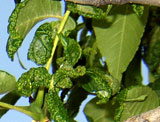Cottony ash psyllid
This insect is an invasive pest and is new to Calgary. Black and Manchurian Ash trees are particularly affected.
What you can do
If your tree is infested with the cottony ash psyllid, proper timing of treatments is crucial. The soap / permethrin mix works well when applied during the insect’s early nymph stage, so treatment should occur in the first week of June and again in the first week of July. Homeowners should monitor trees daily beginning in spring and apply a soap / permethrin mix immediately upon detection of psyllid nymphs and / or the white, cottony material produced by this stage. More than one application may be necessary. Do this again beginning about the first week of July in preparation for the second generation. Once the psyllid adult stage is reached, it is too late and control measures are largely ineffective.

Controlling the cottony ash psyllid
The most effective weapon against this pest is a soap / permethrin treatment known as Trounce®. Because of the lifecycle of this insect, Trounce treatments should commence about the first week of June and again about the first week of July. After that, as the insect matures, it becomes more difficult to treat the tree.
Why cottony ash psyllids are bad for our trees
The Ash Psyllid feeds by piercing leaf tissue and utilizing plant juices. All of the damage is done by the immature (nymph) stage and damage can be severe due to feeding nymphs injecting a toxin into tree leaves. These insects feed are hatched in June and July and feed throughout the summer months, often until late August. Adults are highly active and resemble tiny cicadas.
Symptoms include curled or wilted ("cauliflowered") leaves and premature leaf drop in summer. Feeding nymphs are surrounded by a cottony material enclosed within the leaf.

